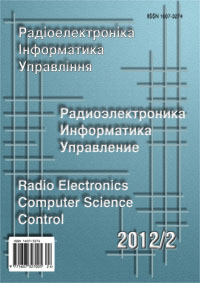SOLVING THE MATRIX 3× N GAME FOR COMBINING OPTIMALLY ALGORITHMS OF THE NEURONET LEARNING WITH IDENTIFICATION ERROR MEASURE AFTER THE LEARNING TIME BY A VOLUME OF THE CONSUMED RESOURCES
DOI:
https://doi.org/10.15588/1607-3274-2012-2-22Keywords:
neuronet, indexes of neuronet, algorithms for learning, decision making problem, matrix game, second player optimal strategy, Bayes-Laplace criterion.Abstract
Solving the matrix 3× N game for combining optimally algorithms of the neuronet learning with identification error measure after the learning time by a volume of the consumed resources A neural network is considered with three interdependent indexes: identification error measure, being acquired after the learning time by one of the N available algorithms for the neuronet learning, corresponds to some volume of the consumed resources. For condition of unfeasibility of pointing at the priority and ranking quantitatively these indexes we suggested the conversion into the corresponding 3× N game and its solution in the form of the second player optimal strategy, with whose probabilities the algorithms for the neuronet learning should be combined. Despite the primary inadmissibility of the Bayes-Laplace criterion for optimal algorithm selection this criterion applicability is supported only on the expiry of a certain time period of the neuronet functioning, when the point evaluation of its indexes weights becomes available. In giving an example with four algorithms for the neuronet learning, we calculated its guaranteed indexes after having combined those algorithms optimally, where worsening of such indexes is also demonstrated by the other approach.Downloads
Published
How to Cite
Issue
Section
License
Copyright (c) 2014 V.V. Romanuke

This work is licensed under a Creative Commons Attribution-ShareAlike 4.0 International License.
Creative Commons Licensing Notifications in the Copyright Notices
The journal allows the authors to hold the copyright without restrictions and to retain publishing rights without restrictions.
The journal allows readers to read, download, copy, distribute, print, search, or link to the full texts of its articles.
The journal allows to reuse and remixing of its content, in accordance with a Creative Commons license СС BY -SA.
Authors who publish with this journal agree to the following terms:
-
Authors retain copyright and grant the journal right of first publication with the work simultaneously licensed under a Creative Commons Attribution License CC BY-SA that allows others to share the work with an acknowledgement of the work's authorship and initial publication in this journal.
-
Authors are able to enter into separate, additional contractual arrangements for the non-exclusive distribution of the journal's published version of the work (e.g., post it to an institutional repository or publish it in a book), with an acknowledgement of its initial publication in this journal.
-
Authors are permitted and encouraged to post their work online (e.g., in institutional repositories or on their website) prior to and during the submission process, as it can lead to productive exchanges, as well as earlier and greater citation of published work.






